Solar eclipse of January 14, 1926
A total solar eclipse occurred on January 14, 1926. A solar eclipse occurs when the Moon passes between Earth and the Sun, thereby totally or partly obscuring the image of the Sun for a viewer on Earth. A total solar eclipse occurs when the Moon's apparent diameter is larger than the Sun's, blocking all direct sunlight, turning day into darkness. Totality occurs in a narrow path across Earth's surface, with the partial solar eclipse visible over a surrounding region thousands of kilometres wide. Totality was visible from French Equatorial Africa (the part now belonging to Central African Republic), northeastern Belgian Congo (today's DR Congo), southwestern tip of Anglo-Egyptian Sudan (the part now belonging to South Sudan), British Uganda (today's Uganda), British Kenya (today's Kenya), southern tip of Italian Somaliland (today's Somalia), British Seychelles (today's Seychelles), Dutch East Indies (today's Indonesia), North Borneo (now belonging to Malaysia), and Philippines.
| Solar eclipse of January 14, 1926 | |
|---|---|
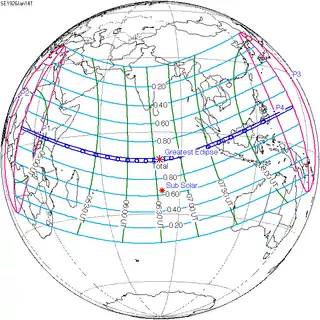 Map | |
| Type of eclipse | |
| Nature | Total |
| Gamma | 0.1973 |
| Magnitude | 1.043 |
| Maximum eclipse | |
| Duration | 251 sec (4 m 11 s) |
| Coordinates | 10.1°S 82.3°E |
| Max. width of band | 147 km (91 mi) |
| Times (UTC) | |
| Greatest eclipse | 6:36:58 |
| References | |
| Saros | 130 (47 of 73) |
| Catalog # (SE5000) | 9341 |
Related eclipses
Solar eclipses 1924–1928
This eclipse is a member of a semester series. An eclipse in a semester series of solar eclipses repeats approximately every 177 days and 4 hours (a semester) at alternating nodes of the Moon's orbit.[1]
| Solar eclipse series sets from 1924–1928 | ||||
|---|---|---|---|---|
| Ascending node | Descending node | |||
| 115 | July 31, 1924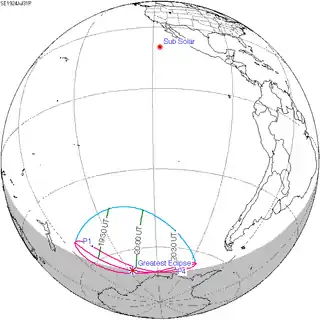 Partial |
120 | January 24, 1925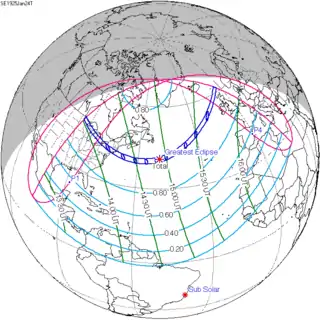 Total | |
| 125 | July 20, 1925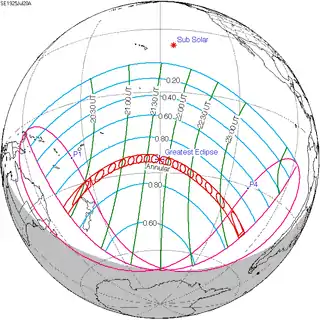 Annular |
130 | January 14, 1926 Total | |
| 135 | July 9, 1926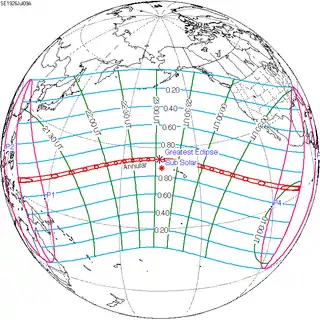 Annular |
140 | January 3, 1927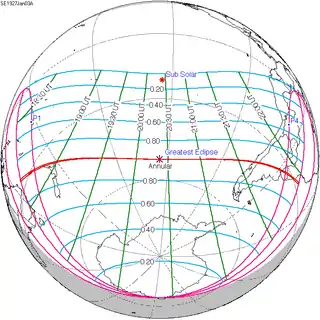 Annular | |
| 145 | June 29, 1927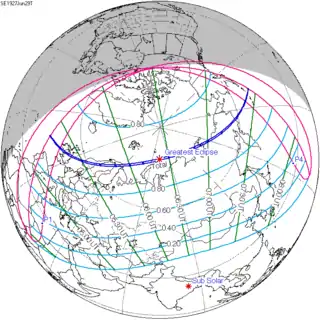 Total |
150 | December 24, 1927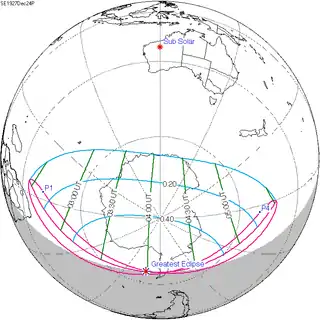 Partial | |
| 155 | June 17, 1928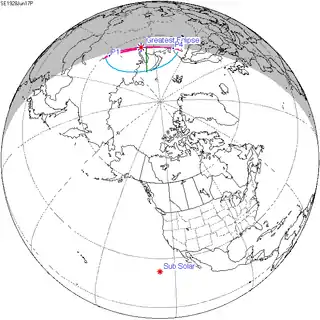 Partial | |||
Saros 130
This eclipse is a part of Saros cycle 130, repeating every 18 years, 11 days, containing 73 events. The series started with partial solar eclipse on August 20, 1096. It contains total eclipses from April 5, 1475 through July 18, 2232. There are no annular eclipses in the series. The series ends at member 73 as a partial eclipse on October 25, 2394. The longest duration of totality was 6 minutes, 41 seconds on July 11, 1619. All eclipses in this series occurs at the Moon’s descending node.[2]
| Series members 43–56 between 1853 and 2300 | ||
|---|---|---|
| 43 | 44 | 45 |
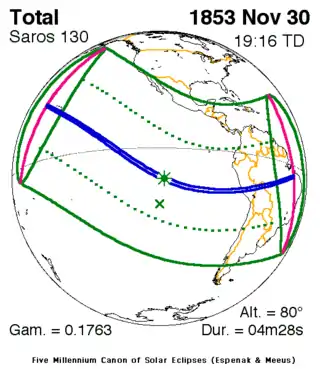 November 30, 1853 |
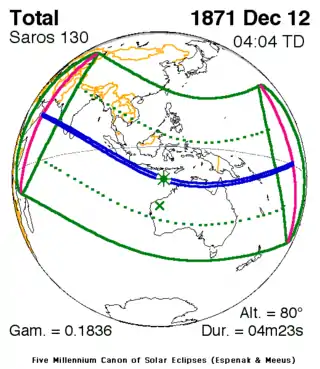 December 12, 1871 |
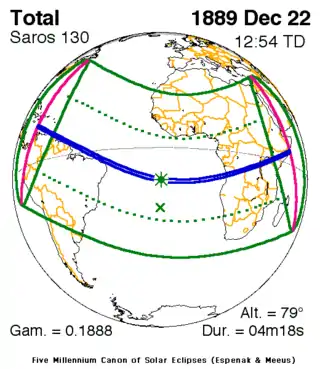 December 22, 1889 |
| 46 | 47 | 48 |
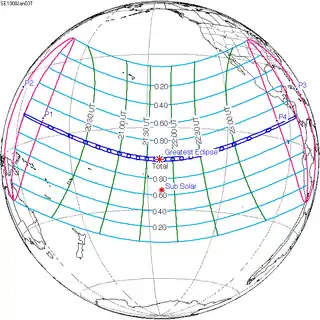 January 3, 1908 |
 January 14, 1926 |
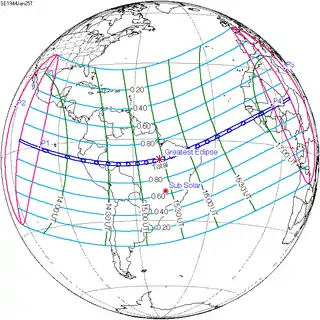 January 25, 1944 |
| 49 | 50 | 51 |
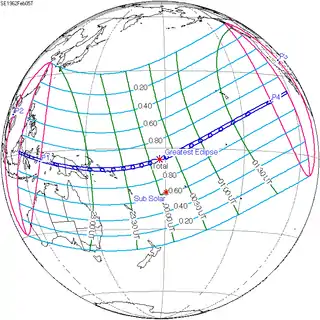 February 5, 1962 |
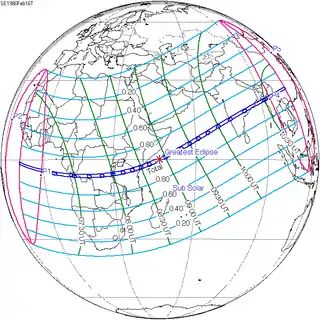 February 16, 1980 |
 February 26, 1998 |
| 52 | 53 | 54 |
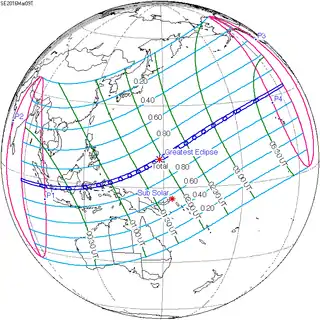 March 9, 2016 |
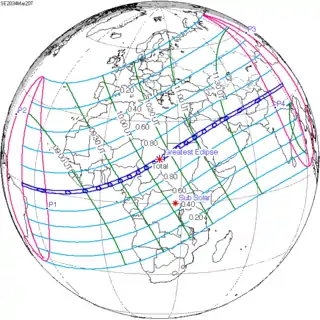 March 20, 2034 |
 March 30, 2052 |
| 55 | 56 | 57 |
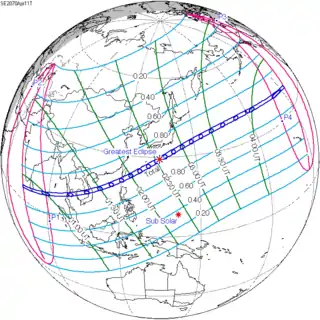 April 11, 2070 |
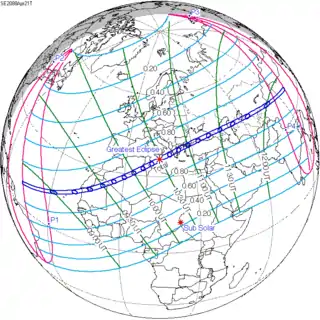 April 21, 2088 |
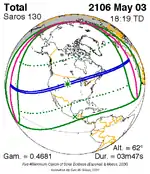 May 3, 2106 |
| 58 | 59 | 60 |
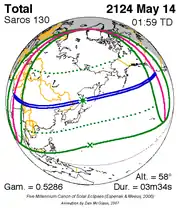 May 14, 2124 |
 May 25, 2142 |
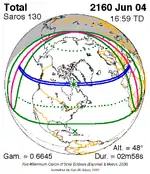 June 4, 2160 |
| 61 | 62 | 63 |
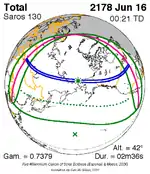 June 16, 2178 |
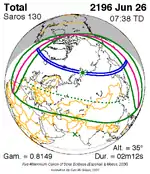 June 26, 2196 |
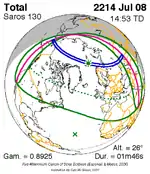 July 8, 2214 |
| 64 | 65 | 66 |
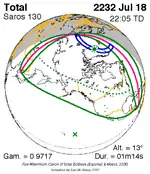 July 18, 2232 |
 July 30, 2250 |
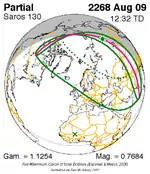 August 9, 2268 |
| 67 | ||
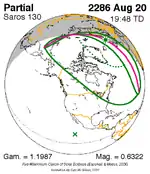 August 20, 2286 | ||
Inex series
This eclipse is a part of the long period inex cycle, repeating at alternating nodes, every 358 synodic months (≈ 10,571.95 days, or 29 years minus 20 days). Their appearance and longitude are irregular due to a lack of synchronization with the anomalistic month (period of perigee). However, groupings of 3 inex cycles (≈ 87 years minus 2 months) comes close (≈ 1,151.02 anomalistic months), so eclipses are similar in these groupings.
| Inex series members between 1901 and 2100: | ||
|---|---|---|
 January 14, 1926 (Saros 130) |
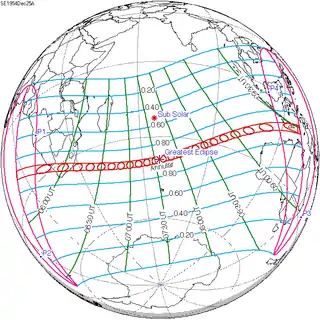 December 25, 1954 (Saros 131) |
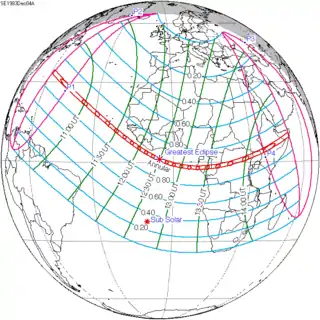 December 4, 1983 (Saros 132) |
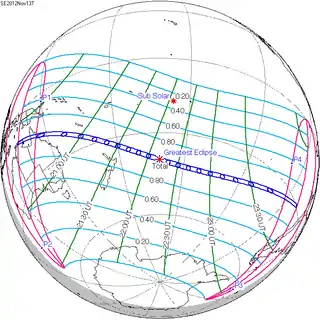 November 13, 2012 (Saros 133) |
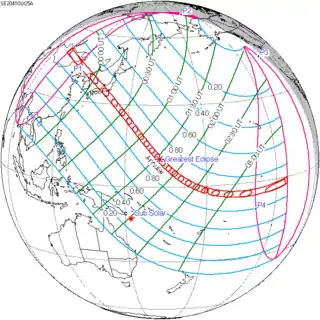 October 25, 2041 (Saros 134) |
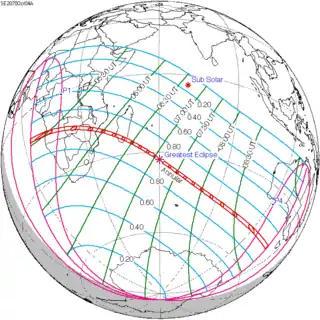 October 4, 2070 (Saros 135) |
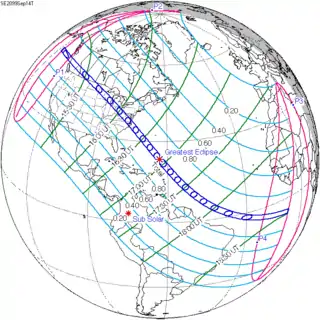 September 14, 2099 (Saros 136) |
||
Tritos series
This eclipse is a part of a tritos cycle, repeating at alternating nodes every 135 synodic months (≈ 3986.63 days, or 11 years minus 1 month). Their appearance and longitude are irregular due to a lack of synchronization with the anomalistic month (period of perigee), but groupings of 3 tritos cycles (≈ 33 years minus 3 months) come close (≈ 434.044 anomalistic months), so eclipses are similar in these groupings.
| Series members between 1801 and 2100 | |||
|---|---|---|---|
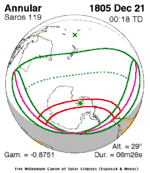 December 21, 1805 (Saros 119) |
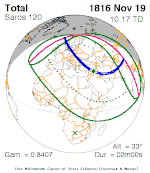 November 19, 1816 (Saros 120) |
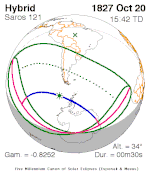 October 20, 1827 (Saros 121) | |
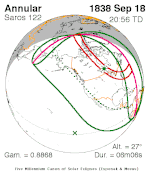 September 18, 1838 (Saros 122) |
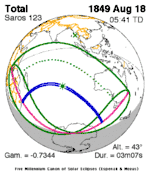 August 18, 1849 (Saros 123) |
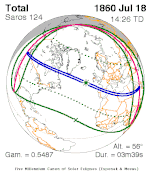 July 18, 1860 (Saros 124) | |
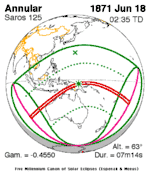 June 18, 1871 (Saros 125) |
 May 17, 1882 (Saros 126) |
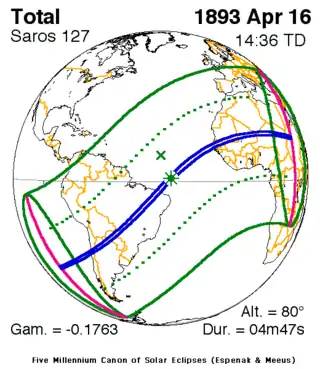 April 16, 1893 (Saros 127) | |
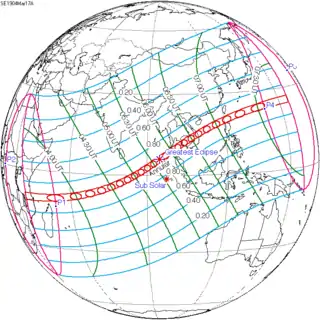 March 17, 1904 (Saros 128) |
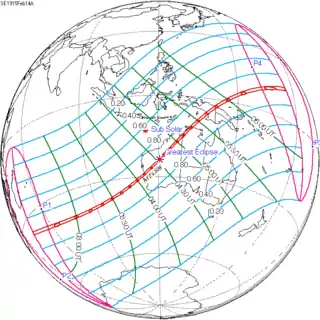 February 14, 1915 (Saros 129) |
 January 14, 1926 (Saros 130) | |
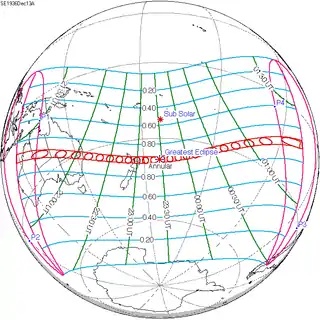 December 13, 1936 (Saros 131) |
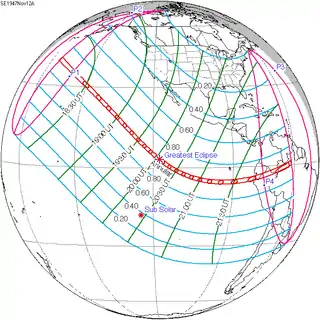 November 12, 1947 (Saros 132) |
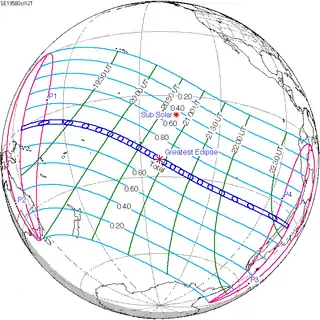 October 12, 1958 (Saros 133) | |
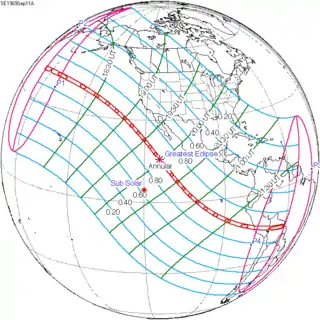 September 11, 1969 (Saros 134) |
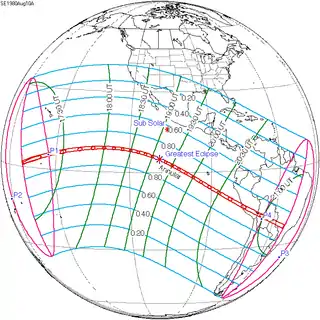 August 10, 1980 (Saros 135) |
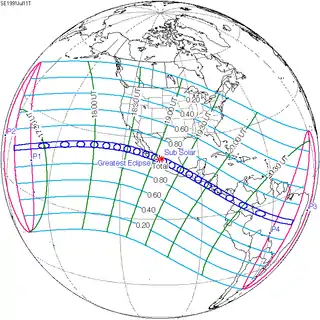 July 11, 1991 (Saros 136) | |
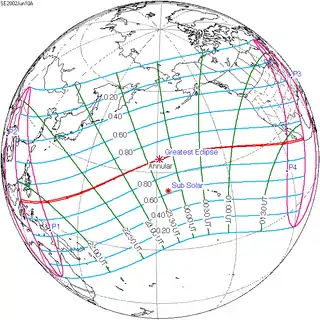 June 10, 2002 (Saros 137) |
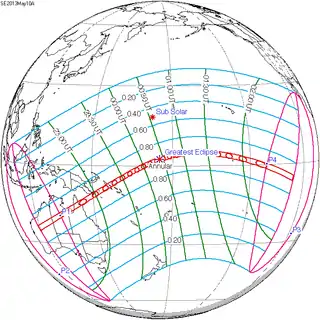 May 10, 2013 (Saros 138) |
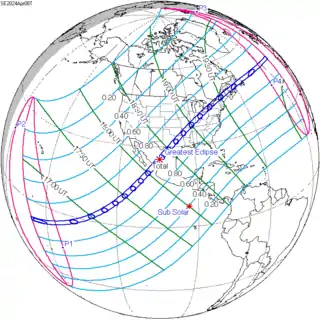 April 8, 2024 (Saros 139) | |
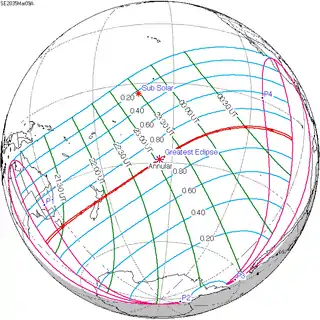 March 9, 2035 (Saros 140) |
 February 5, 2046 (Saros 141) |
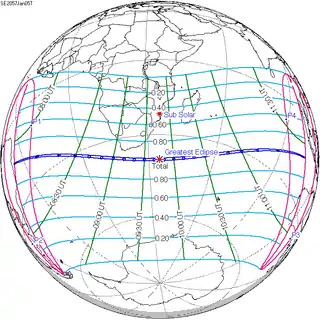 January 5, 2057 (Saros 142) | |
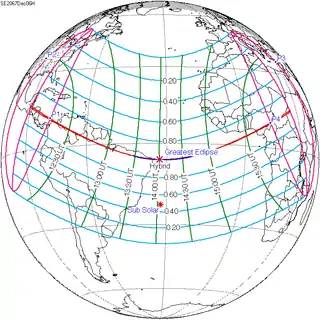 December 6, 2067 (Saros 143) |
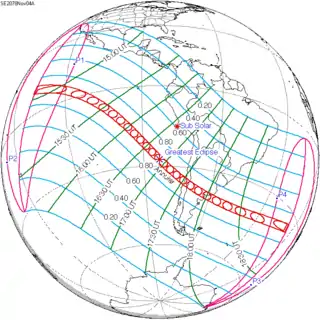 November 4, 2078 (Saros 144) |
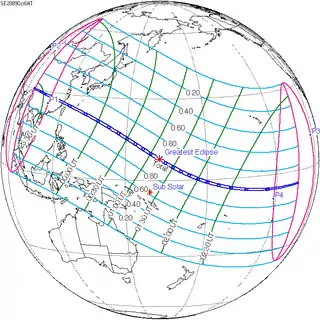 October 4, 2089 (Saros 145) | |
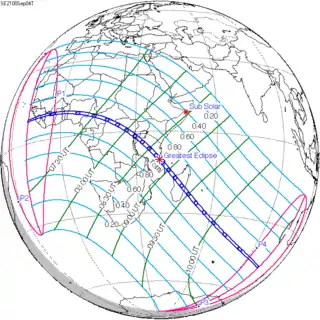 September 4, 2100 (Saros 146) |
|||
In the 22nd century:
- Solar Saros 147: Annular Solar Eclipse of 2111 Aug 04
- Solar Saros 148: Total Solar Eclipse of 2122 Jul 04
- Solar Saros 149: Total Solar Eclipse of 2133 Jun 03
- Solar Saros 150: Annular Solar Eclipse of 2144 May 03
- Solar Saros 151: Annular Solar Eclipse of 2155 Apr 02
- Solar Saros 152: Total Solar Eclipse of 2166 Mar 02
- Solar Saros 153: Annular Solar Eclipse of 2177 Jan 29
- Solar Saros 154: Annular Solar Eclipse of 2187 Dec 29
- Solar Saros 155: Total Solar Eclipse of 2198 Nov 28
In the 23rd century:
- Solar Saros 156: Annular Solar Eclipse of 2209 Oct 29
- Solar Saros 157: Annular Solar Eclipse of 2220 Sep 27
- Solar Saros 158: Total Solar Eclipse of 2231 Aug 28
- Solar Saros 159: Partial Solar Eclipse of 2242 Jul 28
- Solar Saros 160: Partial Solar Eclipse of 2253 Jun 26
- Solar Saros 161: Partial Solar Eclipse of 2264 May 26
- Solar Saros 162: Partial Solar Eclipse of 2275 Apr 26
- Solar Saros 163: Partial Solar Eclipse of 2286 Mar 25
- Solar Saros 164: Partial Solar Eclipse of 2297 Feb 22
Notes
- van Gent, R.H. "Solar- and Lunar-Eclipse Predictions from Antiquity to the Present". A Catalogue of Eclipse Cycles. Utrecht University. Retrieved 6 October 2018.
- "Saros Series catalog of solar eclipses". NASA.
References
- Earth visibility chart and eclipse statistics Eclipse Predictions by Fred Espenak, NASA/GSFC
- Photo of Solar Corona January 14, 1926
- Personal Experiences at Eclipse Expeditions, By S. A. Mitchell, Director of the Leander McCormick Observatory, University of Virginia
.jpg.webp)

